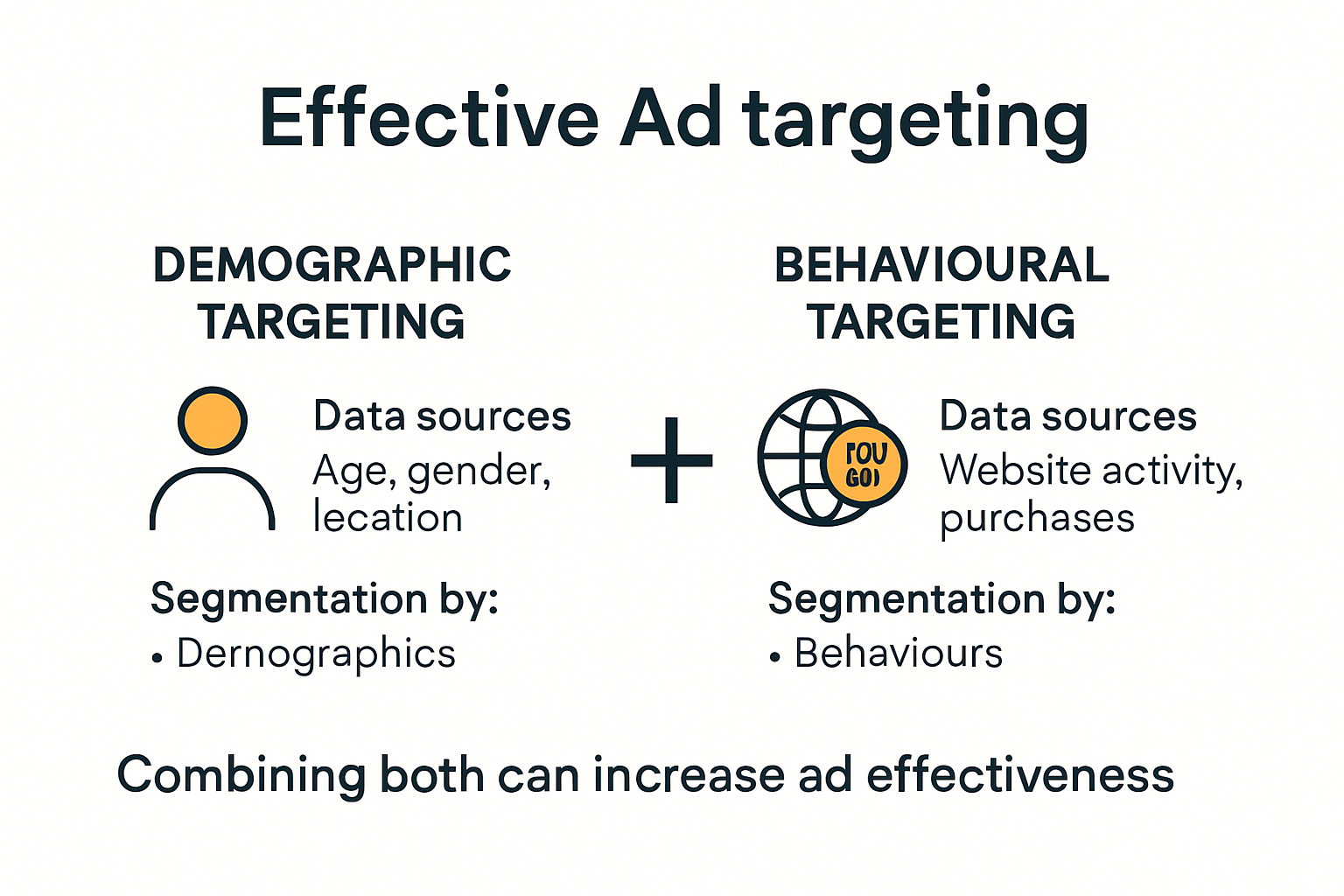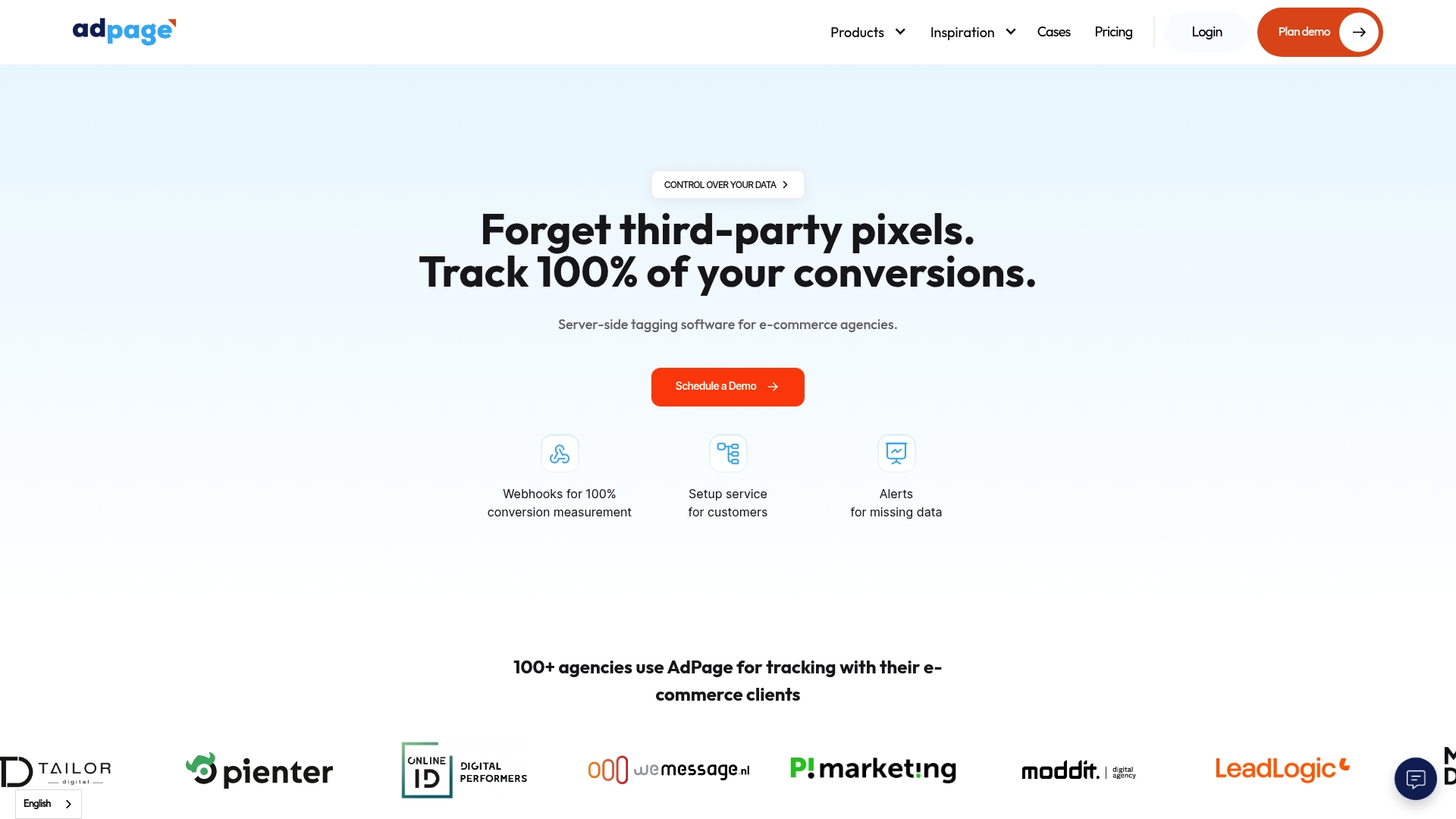E-commerce businesses are pouring more money than ever into online ads and data-driven marketing. Yet research from Forrester reveals that advanced segmentation can slash advertising costs by up to 30% while improving effectiveness. Most would assume success comes from simply throwing bigger budgets at campaigns. In reality, it is the smarter targeting and fresh personalization techniques that truly set high-performing brands apart in 2025.
Table of Contents
- Understanding Core Ad Targeting Methods
- Leveraging Data And Analytics For Precision
- Personalization Techniques To Increase Conversions
- Optimizing Ad Spend With Smart Segmentation.
Quick Summary
| Takeaway | Explanation |
|---|---|
| Demographic and Behavioural Targeting. | Employ demographic targeting to segment audiences by age, gender, and more, while utilizing behavioral targeting to analyze user interactions for enhanced ad relevance and conversion rates. |
| Leverage Advanced Data Analytics | Utilize predictive analytics and machine learning to understand customer behavior, including churn risk and purchase likelihood, significantly boosting marketing performance. |
| Dynamic Content Personalization | Implement dynamic content personalization to adjust web experiences instantly based on user behavior, aiming to increase conversion rates by substantially tailoring recommendations. |
| Optimize Ad Spend with Smart Segmentation | Apply advanced audience stratification techniques to identify high-potential customer segments and reduce advertising costs while enhancing campaign effectiveness through precision targeting. |
| AI-Driven Personalization Strategies | Harness AI technologies to create personalized marketing experiences, such as predictive product recommendations and tailored communication, while ensuring user privacy is respected. |
Understanding Core Ad Targeting Methods
Effective ad targeting strategies have transformed digital marketing, enabling businesses to connect with precise audience segments with unprecedented accuracy. As e-commerce platforms evolve, understanding core ad targeting methods becomes crucial for maximizing marketing investments and driving conversion rates.
Demographic and Behavioural Targeting.
Demographic targeting represents a foundational approach in digital advertising. Marketers can segment audiences based on critical characteristics such as age, gender, income level, education, and occupation. Nielsen Research indicates that precise demographic targeting can improve ad relevance by up to 45%.
Behavioural targeting goes beyond basic demographics, analyzing user interactions, browsing history, purchase patterns, and engagement metrics. Google Marketing Insights suggests that behavioral targeting can increase conversion rates by approximately 37% compared to non-targeted advertising approaches.

Advanced Targeting Technologies
Machine learning and artificial intelligence have revolutionized ad targeting capabilities. These technologies enable dynamic audience segmentation by processing complex data signals in real time. Advanced targeting methods now incorporate predictive analytics, allowing marketers to anticipate user preferences and intent with remarkable precision.
Contextual targeting has emerged as a sophisticated alternative to traditional demographic approaches. This method analyses webpage content, user context, and real-time environmental factors to deliver highly relevant advertisements. By understanding the precise moment and context of user engagement, marketers can craft more resonant and compelling ad experiences.
Serverside tracking technologies play a critical role in modern ad targeting strategies. By implementing advanced tracking mechanisms, businesses can capture comprehensive user interaction data while maintaining strict privacy compliance. This approach enables more nuanced understanding of user journeys and more intelligent ad placement.
As digital ecosystems become increasingly complex, successful ad targeting requires a multifaceted approach that balances technological sophistication with user privacy and consent. Marketers must continuously adapt their strategies, leveraging emerging technologies while maintaining ethical data collection practices.
The future of effective ad targeting strategies lies in the seamless integration of data intelligence, machine learning algorithms, and user-centric design principles. By understanding and implementing these core targeting methods, e-commerce businesses can create more personalized, engaging, and ultimately successful marketing campaigns.
Leveraging Data and Analytics for Precision
Data and analytics have become the cornerstone of precision marketing in e-commerce, transforming how businesses understand and engage with their target audiences. By harnessing advanced analytical techniques, companies can unlock deep insights that drive more effective ad targeting strategies.
Predictive Analytics and Machine Learning
Predictive analytics represents a powerful approach to understanding customer behavior and potential future actions. Gartner Research reveals that businesses using predictive analytics can achieve up to 23% higher marketing performance compared to traditional methods. Machine learning algorithms analyze vast datasets, identifying complex patterns and correlations that human analysts might miss.
Key applications of predictive analytics include:
- Customer Lifetime Value Prediction: Identifying high-potential customers
- Churn Risk Assessment: Proactively addressing potential customer attrition
- Purchase Probability Modeling: Estimating likelihood of future purchases
Advanced Segmentation Techniques
Sophisticated data segmentation goes beyond basic demographic categorization. Harvard Business Review highlights the importance of multi-dimensional segmentation that combines behavioral, psychographic, and contextual data points. This approach enables hyper-personalized marketing strategies that resonate more deeply with individual customer profiles.
Serverside tracking technologies play a crucial role in capturing comprehensive user interaction data. By implementing advanced tracking mechanisms, businesses can gather nuanced insights while maintaining strict privacy compliance. This approach allows for more intelligent data collection and analysis, enabling marketers to create more targeted and effective advertising campaigns.
Real-Time Analytics and Dynamic Targeting
Real-time analytics has emerged as a game-changing capability for precision marketing. Modern analytical tools can process and interpret user data instantaneously, allowing for dynamic ad targeting that adapts to user behavior in milliseconds. This approach enables marketers to deliver highly contextual and personalized advertising experiences.
The integration of artificial intelligence with analytics platforms has further enhanced precision targeting capabilities. Advanced algorithms can now:
- Predict User Intent: Anticipate potential customer actions
- Optimize Ad Placement: Determine most effective advertising channels
- Personalize Content: Dynamically adjust messaging based on user interactions
Successful data-driven marketing requires a holistic approach that balances technological capabilities with ethical data use. Businesses must navigate the complex landscape of data privacy regulations while leveraging advanced analytical techniques to drive marketing effectiveness.
As e-commerce continues to evolve, the ability to extract meaningful insights from complex datasets will become increasingly critical. Companies that master the art of data analytics will gain a significant competitive advantage, creating more personalized, engaging, and ultimately successful marketing strategies.
Personalization Techniques to Increase Conversions

Personalization has emerged as a critical strategy for e-commerce businesses seeking to enhance user engagement and drive conversion rates. By creating tailored experiences that resonate with individual customers, brands can significantly improve their marketing effectiveness and customer loyalty.
Dynamic Content Personalization
Dynamic content personalization represents a sophisticated approach to creating individualized user experiences. Adobe Digital Insights reports that personalized content can increase conversion rates by up to 35% compared to generic marketing approaches. This technique involves dynamically adjusting website content, product recommendations, and messaging based on user-specific data points.
Key elements of dynamic personalization include:
- Real-time Content Adaptation: Changing website elements instantly based on user behavior
- Contextual Recommendations: Suggesting products aligned with individual user preferences
- Personalized User Journeys: Tailoring navigation and interaction paths for each visitor
To help you compare how various personalization techniques contribute to increased conversions, the following table summarizes their key functions and associated benefits mentioned in this section:
| Technique | Key Function | Benefit |
|---|---|---|
| Real-time Content Adaptation | Instantly adjusts website elements | Personal, timely, boosts engagement |
| Contextual Recommendations | Suggests products based on preferences | Increases relevance, likely conversion |
| Personalized User Journeys | Tailors navigation/interactions | Improves experience, higher conversion rate |
| Predictive Product Recommendations | Uses AI to suggest likely purchases | Drives up-sell/cross-sell conversion |
| Dynamic Pricing Strategies | Customizes price/promotion per user | Maximizes revenue, appeals to individuals |
| Personalized Communication Timing | Optimizes when to send messages | Higher open/click rates, better engagement |
Behavioural Targeting and Segmentation.
Advanced behavioral targeting allows marketers to create highly nuanced audience segments. McKinsey Research indicates that personalized marketing strategies can deliver five to eight times the return on investment compared to traditional broad-based approaches.
Serverside tracking technologies enable more sophisticated behavioral analysis by capturing comprehensive user interaction data. This approach allows businesses to develop more intelligent segmentation strategies that go beyond surface-level demographic information. By understanding deeper behavioral patterns, marketers can create more meaningful and resonant personalization strategies.
AI-Driven Personalization Strategies
Artificial intelligence has revolutionized personalization capabilities, enabling unprecedented levels of user experience customization. Machine learning algorithms can now process complex datasets to generate highly individualized marketing experiences that adapt in real time.
Advanced AI personalization techniques include:
- Predictive Product Recommendations: Suggesting items based on comprehensive user behavior analysis
- Dynamic Pricing Strategies: Adjusting pricing and promotions for individual users
- Personalized Communication Timing: Optimising message delivery based on individual engagement patterns
Successful personalization requires a delicate balance between data-driven insights and user privacy. Businesses must implement transparent data collection practices that respect user consent while delivering valuable, tailored experiences.
The future of e-commerce personalization lies in creating seamless, intelligent interactions that feel natural and intuitive. By leveraging advanced technologies and maintaining a user-centric approach, businesses can transform generic marketing efforts into highly engaging, conversion-driving experiences that truly resonate with individual customers.
Optimizing Ad Spend with Smart Segmentation
Effective ad spend management has become a critical challenge for e-commerce businesses seeking to maximize marketing return on investment. Smart segmentation strategies enable marketers to allocate resources more precisely, targeting high-potential audience groups with tailored messaging and minimizing wasteful advertising expenditure.
Advanced Audience Stratification
Sophisticated audience segmentation goes beyond traditional demographic categorization. Forrester Research indicates that businesses employing advanced segmentation techniques can reduce advertising costs by up to 30% while improving overall campaign effectiveness.
Key approaches to intelligent audience segmentation include:
- Behavioural Clustering: Grouping users based on interaction patterns
- Predictive Value Scoring: Identifying high-potential customer segments
- Contextual Performance Analysis: Evaluating segment performance across different marketing channels
Precision Targeting Methodologies
Precision targeting allows marketers to create highly specific audience groups with remarkable accuracy. Nielsen Marketing Analytics demonstrates that granular targeting can improve advertising efficiency by reducing unnecessary ad impressions and focusing resources on most responsive audience segments.
Serverside tracking technologies play a crucial role in enabling sophisticated targeting strategies. By capturing comprehensive user interaction data while maintaining strict privacy compliance, businesses can develop more nuanced understanding of audience characteristics and behaviors.
Cost-Efficient Resource Allocation
Intelligent resource allocation represents the pinnacle of modern ad spend optimization. Machine learning algorithms can now analyze complex datasets to recommend optimal budget distribution across different audience segments and marketing channels.
Advanced allocation strategies include:
- Dynamic Budget Reallocation: Shifting resources based on real-time performance metrics
- Predictive ROI Modeling: Estimating potential returns before campaign deployment
- Micro-Targeting Efficiency: Identifying most cost-effective audience subsegments
Below is a summary table of key segmentation and targeting techniques highlighted in this section, including their main approach and reported impact on ad spend and efficiency:
| Technique | Main Approach | Reported Impact |
|---|---|---|
| Advanced Segmentation | Combines multiple data points/behaviours | Up to 30% reduction in ad costs; improved effectiveness |
| Behavioural Clustering | Groups users by interaction patterns | More precise targeting; less wasteful spend |
| Predictive Value Scoring | Identifies high-potential segments | Resources focused on most valuable leads |
| Contextual Performance Analysis | Evaluates segments by channel | Informs spending by channel/channel success |
| Precision (Granular) Targeting | Highly specific/nuanced audience groups | Fewer unnecessary impressions, more efficiency |
| Dynamic Budget Reallocation | Adjusts spend based on real-time data | Maximizes ROI, adapts to shifting dynamics |
Successful ad spend optimization requires continuous monitoring and adaptive strategies. Marketers must remain agile, using data-driven insights to refine targeting approaches and maximize marketing investments.
The future of ad spend management lies in creating intelligent, responsive systems that can instantly adapt to changing market conditions and user behaviors. By embracing advanced segmentation techniques and leveraging cutting-edge analytical tools, e-commerce businesses can transform their marketing expenditure from a cost center into a strategic competitive advantage.
Frequently Asked Questions
What are effective ad targeting strategies for e-commerce?
Effective ad targeting strategies for e-commerce include demographic and behavioral targeting, advanced data analytics, dynamic content personalization, and smart segmentation techniques. These methods help businesses reach the right audience and improve conversion rates while optimising ad spend.
How does demographic targeting improve ad performance?
Demographic targeting improves ad performance by segmenting audiences based on age, gender, income, and other characteristics. This precision can increase ad relevance by up to 45%, leading to higher engagement and conversion rates.
What role does predictive analytics play in ad targeting?
Predictive analytics helps e-commerce businesses understand customer behaviors and anticipate future actions. By using machine learning algorithms, companies can identify high-potential customers and assess churn risk, ultimately boosting overall marketing performance.
How can personalization techniques increase conversions in e-commerce?
Personalization techniques, such as dynamic content personalization and AI-driven recommendations, create tailored shopping experiences for users. Studies indicate that personalized marketing can increase conversion rates by up to 35%, making it a vital strategy for e-commerce success.
Unlock Accurate Ad Targeting and Conversion Tracking with AdPage
Are you struggling to execute advanced segmentation or smart targeting in your e-commerce campaigns, only to find that data loss from traditional analytics is hurting your results? As the article highlights, personalization and real-time data are now vital for maximizing ad spend, but many marketers face gaps caused by unreliable tracking methods. AdPage helps you take control. With solutions like server-side tagging, consent management and GDPR-compliant visitor identity services, you can finally monitor 100 percent of your conversions, accurately analyze segmented audiences and make confident marketing decisions.

Imagine reducing wasted ad spend and boosting conversion rates by eliminating tracking blind spots. Discover seamless integrations with platforms like Shopify and WooCommerce, along with easy onboarding and powerful reporting, at AdPage's main website. Ready to see the impact of flawless data and advanced targeting? Visit enhance your conversion tracking today. Insist on precision and watch your e-commerce performance reach new heights.



.png)
